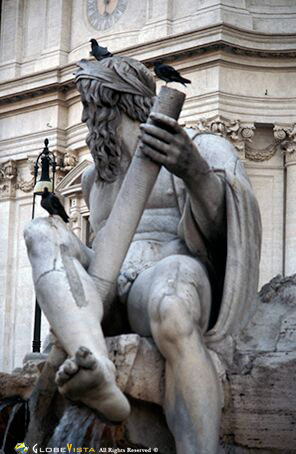The Piazza Navona in Rome was once the location of the Stadium of Domitian, which held athletic competitions since AD 85. The Piazza still maintains the long elongated shape of the stadium and is one of the widest squares in Rome. The piazza is well known for its two magnificent fountains, the Fountain of the Four Rivers and Fountain of Moor.

Fontana dei Fiumi
In 1647, Gian Lorenzo Bernini was commissioned by Pope Innocent X to build the Fountain of the Four Rivers (Fontana dei Fiumi), in the Piazza. Construction of the travertine and marble baroque style fountain began between 1647-51 and represented four rivers, the Danube, Nile, Ganges and Rio della Plata, which were found in four different continents. Pope Innocent X had originally requested that the construction of the fountain be commissioned to Borromini(Bernini’s rival), who had built the church of Sant’ Agnese which is facing the fountain in the piazza. Much to Borromini’s disgust, Bernini was eventually handed the commission.
Arch Rivalry
A story about the rivary between Bernini and Borromini suggests that when Bernini built the Fountain of the Four Rivers he created the statue, representing the Ganges, with its arm raised up deliberately to look as though he is protecting himself from the collapse of the church Borromini built. Whilst the statue representing the Nile is covering his head as if to avoid seeing the sight. Borromini was commissioned by Pope Innocent X to build the Church of Sant’ Agnese in the piazza facing the fountain.
Fountain of Moor (Fontana del Moro)
At the southern end of the piazza, lies the other impressive piece of art, Fountain of Moor (Fontana del Moro). The Fountain was built by Giacomo della Porta, in 1575 and as far as I know, had no arch-rival. The central statue of a Moor, holding a dolphin, was designed by Gian Lorenzo Bernini in the 17th century.
Artificial Lake
At one stage the piazza was used as a fruit and vegetable market. However, strangely enough, between 1652-1866 the piazza was flooded every Saturday, during the month of August, to create an artificial lake.
Fingers Go Missing
During the liberation of Italy the piazza was used as a camp for allied soldiers. The soldiers were responsible for the missing fingers of the statues in the piazza fountains. It is believed they took them home as souvenirs.
Today, the piazza is alive with tourists, cafes and street vendors and is one of the most popular piazzas in Rome.
